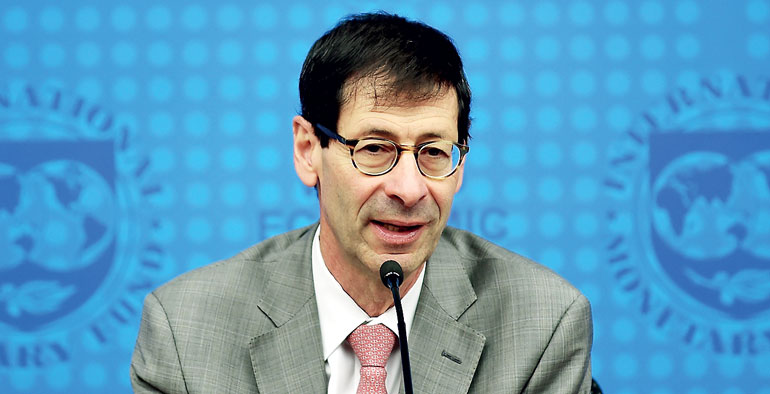Saturday Apr 20, 2024
Saturday Apr 20, 2024
Tuesday, 25 July 2017 01:05 - - {{hitsCtrl.values.hits}}
By Uditha Jayasinghe in Kuala Lumpur
Upward revisions in growth projections for China, Japan and India have helped keep the International Monetary Fund (IMF) mid-year revisions unchanged with developing countries, including Sri Lanka, expected to grow at an average 4.6%.
The projections for the Southeast Asian region have remained robust despite growth numbers for US and UK being downgraded in the latest World Economic Outlook Update 2017, which was launched by the IMF in Kuala Lumpur on Monday. The World Bank last month in its mid-year evaluation estimated 4.7% growth for Sri Lanka in 2017, which is on par with IMF projections.
The Economic Outlook Update only evaluates large economies but country specific details would be released in their next report to be released in October.

The pickup in global growth anticipated in the April World Economic Outlook remains on track, with global output projected to grow by 3.5% in 2017 and 3.6% in 2018, the report said. The growth forecast in the US has been revised down from 2.3% to 2.1% in 2017 and from 2.5% to 2.1% in 2018 mostly on fiscal uncertainty and low expectations of fiscal stimulus.
The growth forecast has also been revised down for the UK for 2017 on weaker-than-expected activity in the first quarter. By contrast, growth projections for 2017 have been revised up for many euro area countries, including France, Germany, Italy, and Spain, where growth for the first quarter of 2017 was generally above expectations. Stronger momentum in domestic demand than previously anticipated was flagged by the IMF indicating a potential boost for Sri Lankan exports to the region.
“Emerging and developing economies are projected to see a sustained pickup in activity, with growth rising from 4.3% in 2016 to 4.6% in 2017 and 4.8% in 2018. These forecasts reflect upward revisions, relative to April, of 0.2% point for 2016, and 0.1% point for 2017,” said IMF Chief Economist Dr. Maurice Obstfeld.
China’s growth is expected to remain at 6.7% in 2017, the same level as in 2016, and to decline only modestly in 2018 to 6.4%. The forecast for 2017 was revised up by 0.1% point, reflecting the stronger than expected outturn in the first quarter of the year underpinned by previous policy easing and supply-side reforms. However, IMF officials acknowledged stronger efforts needed to be made to trim private sector credit growth in China and reduce exposure of State Owned Enterprises.
“In China, failure to continue the recent focus on addressing financial sector risks and curb excessive credit growth, mainly through tighter macroprudential policy settings, could result in an abrupt growth slowdown, with adverse spillovers to other countries through trade, commodity price, and confidence channels,” Dr. Obstfeld added.
Growth in India is forecast to pick up further in 2017 and 2018, in line with the April 2017 forecast. While activity slowed following the currency exchange initiative, growth for 2016––at 7.1%––was higher than anticipated due to strong government spending and data revisions that show stronger momentum in the first part of the year. India is projected to grow at 7.2% this year, the highest in the region.
With a pickup in global trade and strengthening domestic demand, growth in the ASEAN-5 economies is projected to remain robust at around 5%, with generally strong first quarter outturns leading to a slight upward revision for 2017 relative to the April outlook. While risks around the global growth forecast appear broadly balanced in the near term, they remain skewed to the downside over the medium term. On the upside, the cyclical rebound could be stronger and more sustained in Europe, where political risk has diminished. On the downside, rich market valuations and very low volatility in an environment of high policy uncertainty raise the likelihood of a market correction, which could dampen growth and confidence, the report summarised.
Protectionism, rising geopolitical tensions, stagnant wages in developed countries, tension in the Middle East, growing inequality, climate change and policy uncertainty in major economies such as the US were all highlighted as risks in the report.
“Countries in need of fiscal consolidation should do so with growth-friendly measures. Emerging market economies should continue to allow exchange rates to buffer shocks, wherever possible,” the IMF Chief Economist cautioned.